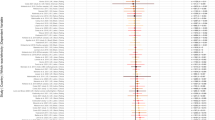Abstract
This paper presents a spatial election model in which candidates have mixed motives: They care both about winning and about the content of their platforms. The predictions of the model are broadly consistent with what we observe empirically: some elections with convergent candidate positions, and some with divergent positions; the prevalence of elections in which the expected vote shares are not equal; candidates' positions reacting in part to those of their opponents; and candidates seeking a balance between what they believe and what they need to advocate to get elected.
Similar content being viewed by others
References
Aldrich J (1983) A Downsian spatial model with party activism. Am Pol Sci Rev 77:974–990
Aranson PH, Ordeshook PC (1972) Spatial strategies for sequential elections. In: Niemi RG, Weisberg HF, (eds) Probability models of collective decision-making. Columbus, Merrill
Coleman J (1971) Internal processes governing party positions in elections. Publ Choice 11:35–60
Comanor WS (1976) The Median voter rule and the theory of political choice. J Publ Econ 5:169–177
Coughlin P, Nitzan S (1981) Directional and local electoral equilibria with probabilistic voting. J Econ Theory 24:226–239
Davis OA, Hinich MJ, Ordeshook PC (1970) An expository development of a mathematical model of the electoral process. Am Pol Sci Rev 64:426–448
Denzau AT, Kats A (1977) Expected plurality voting equilibrium and social choice functions. Rev Econ Stud 44:227–233
Hansson I, Stuart C (1984) Voting competitions with interested politicians: platforms do not converge to the preferences of the Median voter. Public Choice 44:431–441
Hinich MJ (1977) Equilibrium in spatial voting: the Median voter result is an artifact. J Econ Theory 16:208–219
Hinich MJ, Ledyard JO, Ordeshook PC (1972) Nonvoting and the existence of equilibrium under majority rule. J Econ Theory 4:144–153
Kramer GH (1977) A dynamical model of political equilibrium. J Econ Theory 16:310–334
Matthews SA (1979) A simple direction model of electoral competition. Public Choice 34:141–156
McKelvey RD (1975) Policy related voting and electoral equilibrium. Econometrica 43:815–843
Ordeshook PC (1971) Pareto optimality in electoral competition. Am Pol Sci Rev 65:1141–1145
Samuelson L (1984) Electoral equilibria with restricted strategies. Publ Choice 43:307–327
Author information
Authors and Affiliations
Rights and permissions
About this article
Cite this article
Mitchell, D.W. Candidate behavior under mixed motives. Soc Choice Welfare 4, 153–160 (1987). https://doi.org/10.1007/BF00450996
Received:
Accepted:
Issue Date:
DOI: https://doi.org/10.1007/BF00450996




